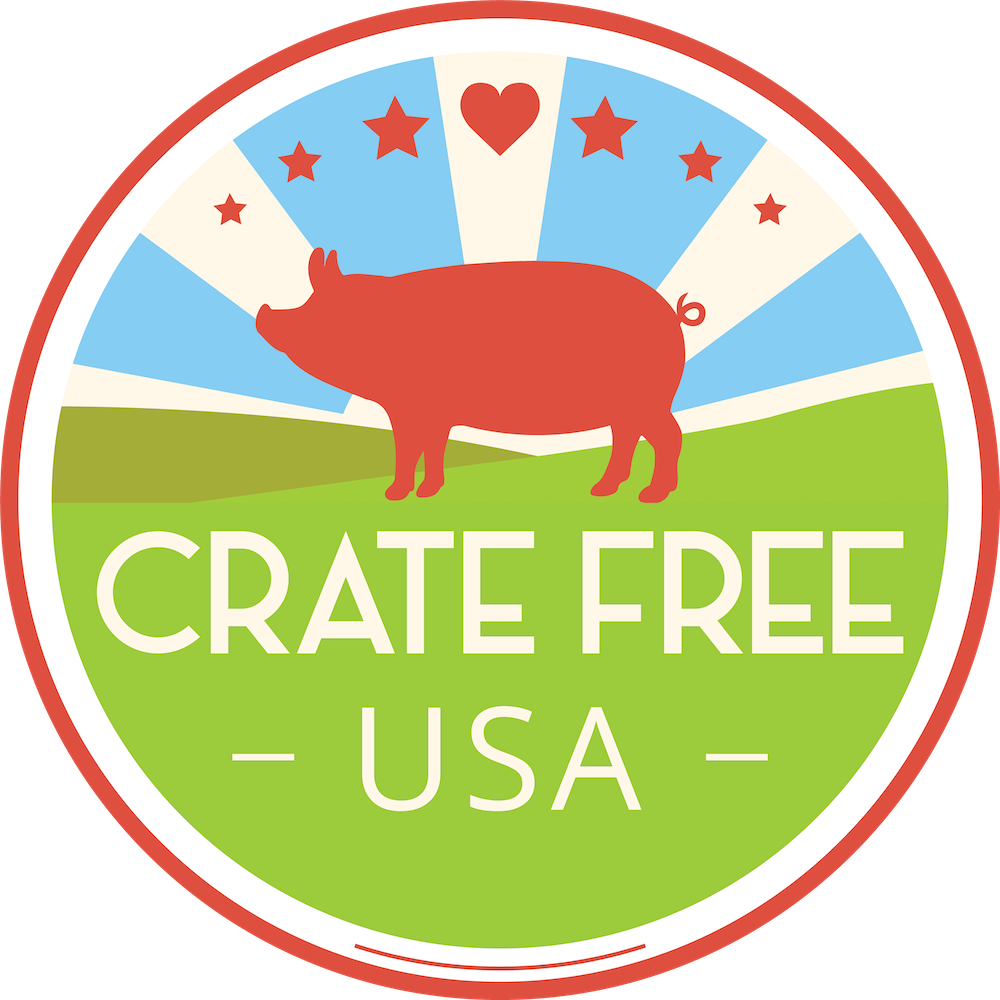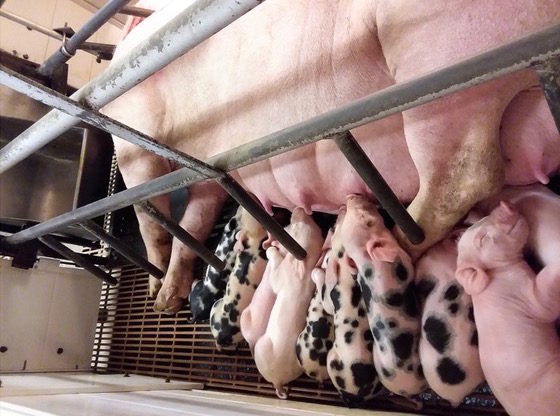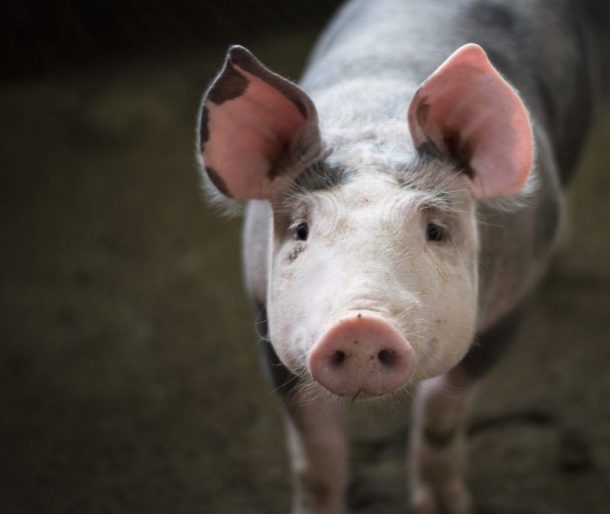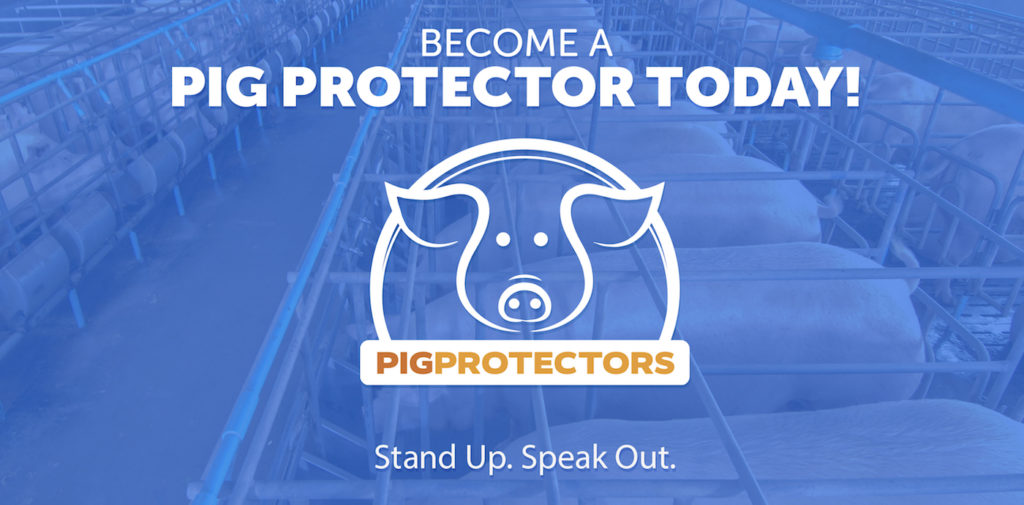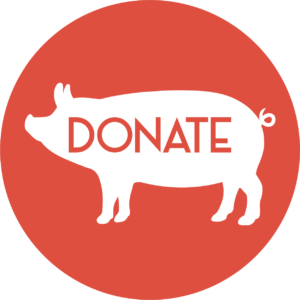The Knox County Pork Producers Association, in Knox County, Illinois, recently shared some photos on their Facebook page of some newborn piglets with their mom. The mother is in a pig farrowing crate, which – according to their post – provides this little family with “their own comfy area.” Personally, I’m not sure what is so “comfy” about lying on a hard, slatted floor, but here is their commentary on the photos:
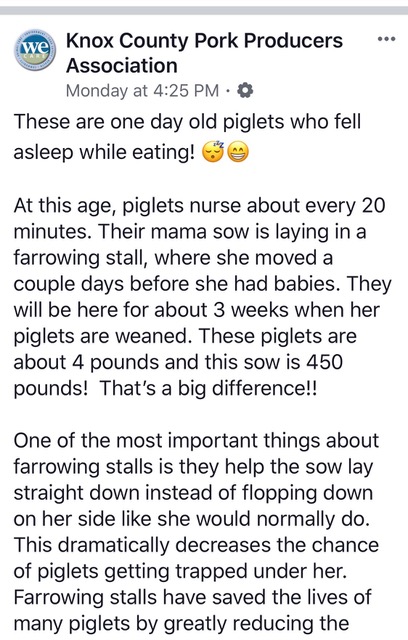
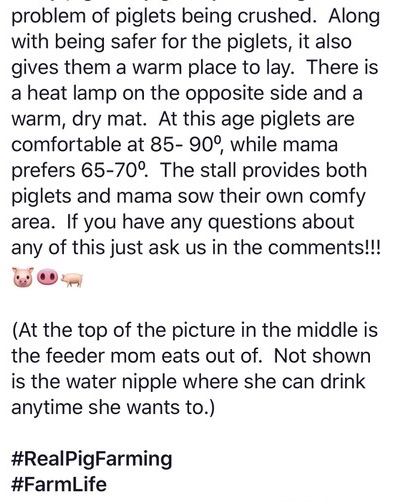
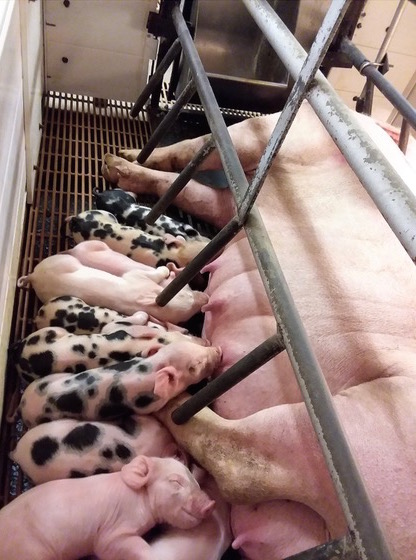
The Problem with Pig Farrowing Crates and Gestation Crates
There are a few facts left out of this narrative about the farrowing stall, however. There are some negative implications to this method of “farming” that consumers should be aware of, so we thought this might be a good opportunity to share some information about why we at Crate Free USA are fundamentally opposed to the use of gestation crates and farrowing stalls.
A Sow Spends Most of Her Life in Extreme Confinement
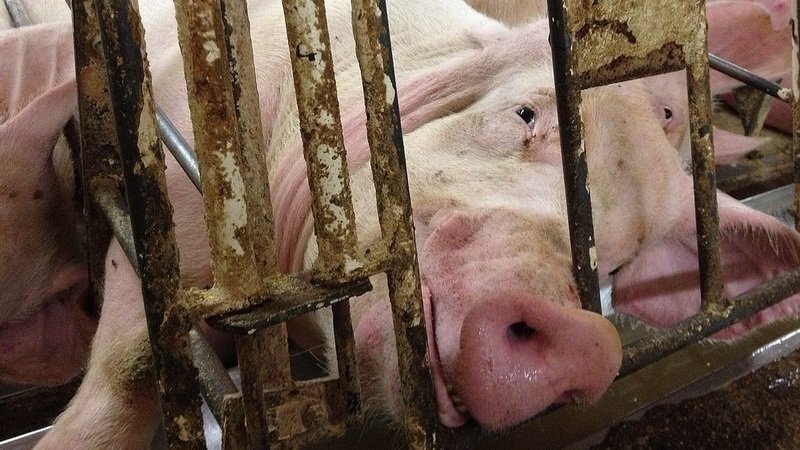
A sow’s pregnancy typically lasts about 114 days, or, just a little less than 4 months.(1) Pregnant sows on factory farming operations will spend the duration of their pregnancies in a gestation crate. As the birth of her piglets nears, she will be transferred to a slightly larger farrowing crate, where she will spend approximately three to four weeks nursing her piglets until they are ready to be weaned(2)(3).
Between the gestation confinement period, and the farrowing confinement period, the sow will spend roughly 5 months in a space not much larger than her body, that prohibits her from turning around or doing anything besides standing up and sitting down. The sow can be ready to be bred again in as little as 4-9 days(4), starting the cycle of confinement all over again.
Given that a sow will have, on average, 2.5 litters per year, for two to three years, the end result is that, between gestation crates and farrowing stalls, a sow will spend roughly ¾ of her lifetime in extreme confinement(5). Imagine, if you can, spending ¾ of your life in an airline seat. Probably not exactly what most people would describe as a “comfy area.”
Crates Prohibit Natural Behaviors
The confinement in itself is bad enough, but another issue with these crates is that they prohibit sows from engaging in several key natural behaviors(6)(7):
- Communal lying
- A hard-wired drive to nest-build
- Inability to get away from other sows during farrowing phase
- Desire to toilet away from feeding and living area
- Foraging opportunities
- Social interaction with other sows
Sows allowed to nest-build will choose soft, deep bedding. If a sow were to accidentally roll onto one of her piglets, the depth and “give” of her nest would help prevent crushing. Farmers often justify the use of farrowing crates by stating that they prevent the sows from crushing their own babies.(8) However, piglets are known to be crushed despite the preventive measures cited as benefits of using farrowing stalls(9).
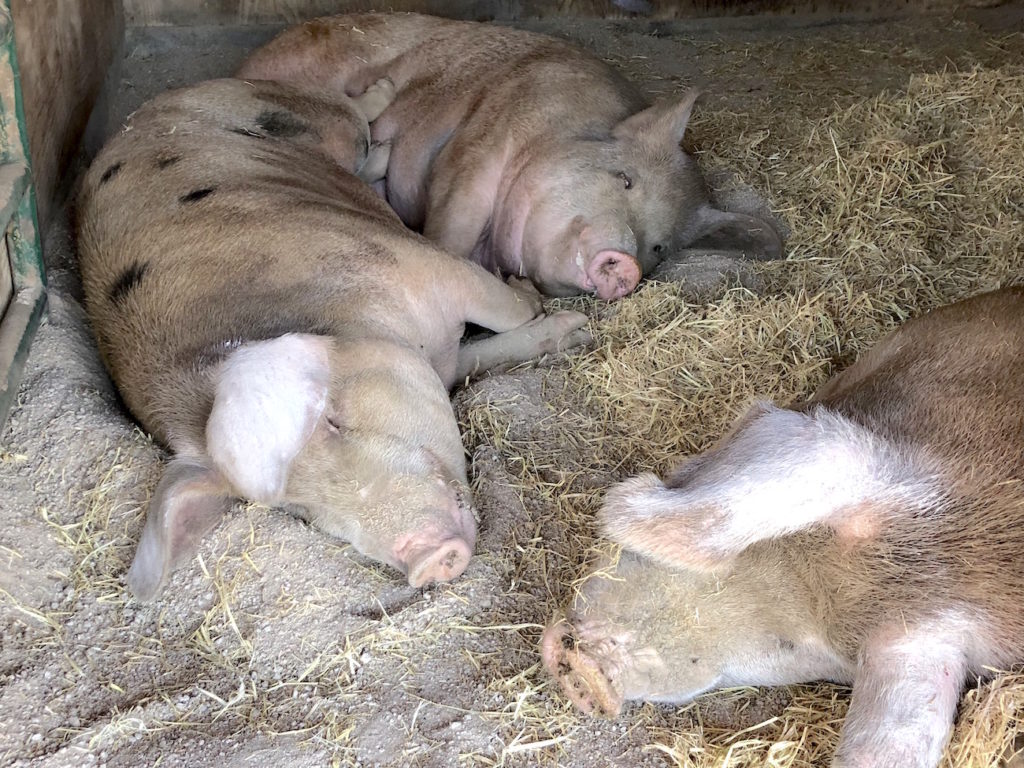
Sleeping Pigs at the Farm Sanctuary. Photo by Christy Slaby.
Crates Cause Injuries and Mental Stress
There are other negative effects of gestation crates and farrowing stalls, including(10)(11):
- The development of abrasions or pressure sores from the bars of the stall
- Limited mobility can lead to joint issues or lameness
- Stalls often consist of uncomfortably hard concrete floors
- Stereotypic behaviors (i.e., bar-biting) resulting from the stress and boredom of confinement
- Lack of enrichment/mental stimulation/social interaction for these highly intelligent and inquisitive animals
Some Farmer’s Defense of Crates
Farmers who utilize gestation and/or farrowing crates will often say that doing so is in the sow’s (or her piglets’) best interests: she does not have to compete for food; the crates limit aggression/fighting between sows; they receive more individualized attention and care(12). The use of gestation/farrowing crates is widely recognized, however, to be cruel and inhumane, and a growing number of consumers believe the costs to the animals do not outweigh the benefits(13). As such, they have been banned in several countries(14), as well as in 12 states in the US (Arizona, California, Colorado, Florida, Maine, Michigan, Ohio, Oregon and Rhode Island)(15).
The use of gestation crates and farrowing stalls is ultimately to the benefit of industrial factory farm producers. They are able to raise more pigs, in less space, resulting in greater profits. This is no kind of life for a thinking, feeling, highly intelligent animal(16).
As we often say, there is something seriously wrong with a food system where the best day of an animals’ life is the day that life is taken. You can spin a happy tale and dress it up with photos of cute little piglets, but at the end of the day, to put it in terms the industry might understand, glorifying the use of the farrowing stall is really just putting lipstick on a pig.
Other Farmers Choose NOT to Use Crates
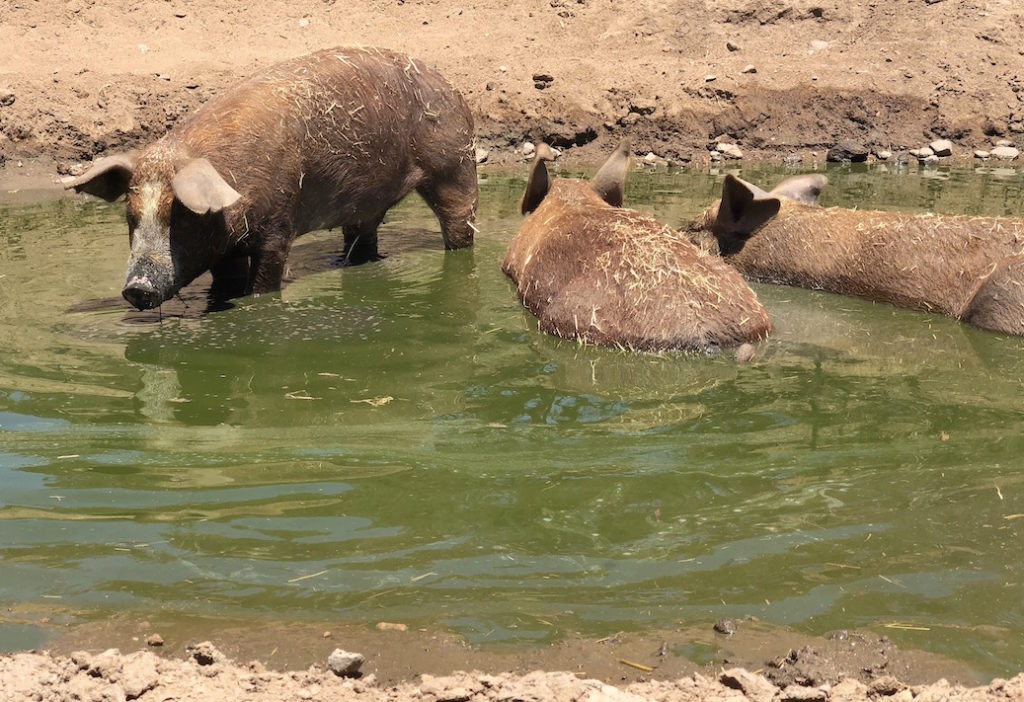
Pigs in Water at Farm Sanctuary. Photo by Christy Slaby.
The good news is, there are farmers who are successfully raising pigs without the use of gestation or farrowing stalls. It is up to you, the consumer, to decide which farmers you wish to support.
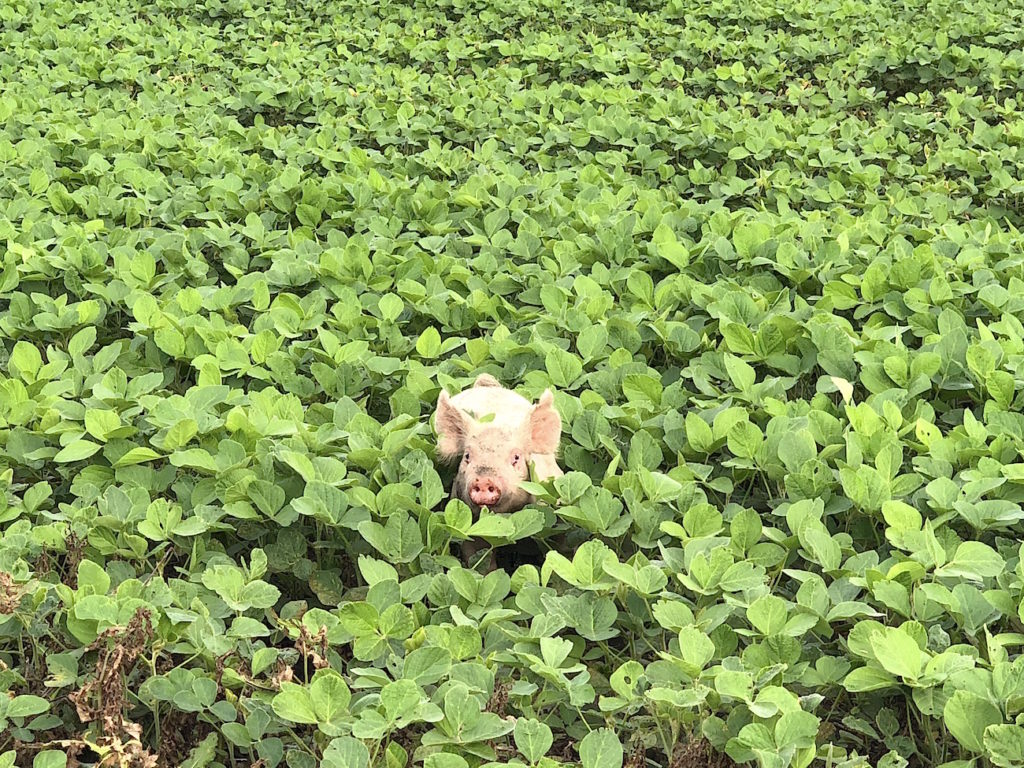
Pig in Field at Locavore Farm. Photo by Christy Slaby.
Remember, more than 95% of grocery store pork is produced by industrial factory farms that utilize gestation crates and/or farrowing stalls.
Sure, it may take a little extra effort to shop for pork products that are produced by small, independent farmers who are pasture-raising their animals humanely, but you can download our free mobile app to help make the process easier. That extra effort is the very least we can do for these animals.
Author bio: Christy Slaby is a life-long animal lover who resides in Illinois. She has been involved in both companion animal and farmed animal advocacy for several years. Christy joined the Crate Free USA team as a volunteer Social Media Coordinator in October 2017.
Sources:
- http://livestocktrail.illinois.edu/porknet/questionDisplay.cfm?ContentID=5642
- http://www.hsvma.org/assets/pdfs/hsvma_veterinary_report_gestation_crates.pdf
- https://www.naturalpigfarming.com/farrowing.htm
- http://www.hsvma.org/assets/pdfs/hsvma_veterinary_report_gestation_crates.pdf
- http://www.hsvma.org/assets/pdfs/hsvma_veterinary_report_gestation_crates.pdf
- https://www.ars.usda.gov/ARSUserFiles/50201500/Farrowing%20System%20Fact%20Sheet.pdf
- https://animalstudiesrepository.org/cgi/viewcontent.cgi?referer=https://www.google.com/&httpsredir=1&article=1026&context=hsus_reps_impacts_on_animals
- https://www.naturalpigfarming.com/
- https://lib.dr.iastate.edu/cgi/viewcontent.cgi?article=1102&context=ans_pubs
- https://animalstudiesrepository.org/cgi/viewcontent.cgi?referer=https://www.google.com/&httpsredir=1&article=1026&context=hsus_reps_impacts_on_animals
- https://www.ars.usda.gov/ARSUserFiles/50201500/Farrowing%20System%20Fact%20Sheet.pdf
- https://www.nationalhogfarmer.com/animal-well-being/getting-right-message-sow-gestation-stalls
- http://www.humanesociety.org/issues/confinement_farm/facts/gestation_crates.html
- http://www.hsi.org/world/canada/work/intensive-confinement/facts/gestation_crates_campaign.html
- https://www.aspca.org/animal-protection/public-policy/farm-animal-confinement-bans
- https://animalstudiesrepository.org/cgi/viewcontent.cgi?article=1042&context=acwp_asie
